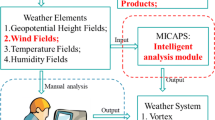Abstract
A relatively fixed structure vector field which includes clockwise vortex, anticlockwise vortex, convergence, divergence, and saddle is defined as axisymmetric vector fields (AVF) in this study. A method for characterizing and classifying the type of flow patterns in 2-dimension actual vector field for the meteorology application is proposed. First of all, the collected AVF samples are transformed to a directional pseudo-color image by means of mapping them to the hue component space in the HSL color model. Secondly, the directional hue difference and similarity degree to the normal AVF are respectively extracted as two features by the technique of image processing. Thirdly, two improved physical properties (vorticity and divergence) of AVF are introduced and improved for this study. Finally, in the experiment, the probability density distribution for every type of AVF samples is employed to analyze the four features advantages and disadvantages on the five AVF patterns classification. The correlation of the features is discussed by the PCA method. The statistics results show that the features are effective to describe the AVF patterns. By training a classifier based on constructing a decision tree, the classification ability of the features is proved on processing different scale and resolution AVF samples by comparing with traditional methods.











Similar content being viewed by others
References
Ausoni CO, Frey P (2014) Geometric algebra for vector fields analysis and visualization: mathematical settings, overview and applications. HAL Id: hal-00920544. http://hal.upmc.fr/hal-00920544v2
Corpetti T, Mémin E, Pérez P (2003) Extraction of singular points from dense motion fields: an analytic approach. J Math Imaging Vision 19:175–198
Dudas D (2013) Vortex extraction of vector fields. PhD thesis, Heidelberg University. 8–10. http://archiv.ub.uni-heidelberg.de/volltextserver/15680/
Dudas D (2008) Vortex core extraction of 3d vector fields based on minimal bending energy, masters thesis, University of Saarland, max Planck Institute for Computer Science
Ebling J, Scheuermann G (2003) Clifford convolution and pattern matching on vector fields. Proceedings of the 14th IEEE Visualization, Seattle, 26–33
Gonzalez RC, Woods RE (2007) Digital image processing, 3rd edn. Pearson
Hanley J, Caballero R (2012) Objective identification and tracking of multicenter cyclones in the ERA-Interim reanalysis dataset. Q J R Meteorol Soc 138:612–625
Helman J, Hesselink L (2011) 3D flow features visualization via fuzzy clustering. Vis Commun:441–449
Ho S-S (2012) An effective vortex detection approach for velocity vector field, 21st International Conference on Pattern Recognition
Hu C, Xu Z, et al. (2015) Video Structured description technology for the new generation video surveillance system. Front Comput Sci 9(6):980–989
Ketelaar J (2015) It is all about the circle: an inventory of circular data. Bachelorthesis Onderwijskunde (200600207)
Letouzey A, Petit B, Boyer E (2011) Surface flow from depth and color images. British Machine Vision Conference, Dundee, Royaume-Uni
Marsland S (2009) Machine Learning-an algorithmic perspective. Chapman & Hall/CRC Chapter 6, 133–153
Mclver DK, Friedl MA (2002) Using prior probabilities in decision-tree classification of remotely sensed data. Remote Sens Environ 81:253–261
Nascimento R, Paixo J, Lopes H, Lewiner T (2010) Topology aware vector field denoising. XXIII Conference on Graphics, Patterns and Images, Sibgrapi, 103–109
Nguyen LT, Molinari J, Thomas D (2014) An objective evaluation of tropical cyclone center identification methods in numerical models. Mon Weather Rev 142:4326–4339
Petz C, Pöthkow K, Hege H-C (2012) Probabilistic local features in uncertain vector fields with spatial correlation. Comput Graphics Forum 31(3):1045–1054. http://onlinelibrary.wiley.com/doi/10.1111/j.14678659.2012.03097.x/pdf.
Pollock S, Mann S (2014) Vortex detection in vector fields using geometric algebra. AACA 24:423–442
Polthier K, Preuss E (2003) Identifying vector field singularities using a discrete hodge decomposition. Visualization and Mathematics III, 113–134
Post FH, Vrolijk B, Hauser H, Laramee RS, Doleisch H (2003) The state of the art in flow visualization: feature extraction and tracking. Comput Graphics Forum 22:775–792
Potvin CK (2013) A variational method for detecting and characterizing convective vortices in Cartesian Wind Fields. Mon Weather Rev 141:3102–3114
Schuchert T, Aach T, Scharr H (2010) Range flow in varying illumination: algorithms and comparisons. Pattern Anal Mach Intell 32:1646–1658
Tu E et al. (2015) Posterior distribution learning (pdl): A novel supervised learning framework using unlabeled samples to improve classification performance. Neurocomputing 157:173–186
Varun AV, Balasubramanian K, Sujith RI (2008) An automated vortex detection scheme using the wavelet transform of the d2 field. Exp Fluids 45:857–868
Webb AR, Copsey KD (2011) Statistical pattern recognition, 3rd edn. Wiley
Wernli H (2006) Surface cyclones in the ERA-40 Dataset (1958–2001). Part I: novel identification method and global climatology. J Atmos Sci 63:2486–2507
Wong KY, Yip CL (2009) Identifying centers of circulating and spiraling vector field patterns and its applications. Pattern Recogn 1373–1387
Wu J, Ma H, Zhou M (2006) Vorticity and vortex dynamics, Springer
Xu H (2011) Extraction and visualization for complex flow field features. PhD. Thesis, National University of Defense Technology 33–57. http://cdmd.cnki.com.cn/Article/CDMD-90002-1011303357.htm
Xu Z et al. (2015) Semantic based representing and organizing surveillance big data using video structural description technology. J Syst Softw 102:217–225
Xu Z et al. (2016) Semantic enhanced cloud environment for surveillance data management using video structural description. Computing 98(1-2):35–54
Zhang L et. al (2013) Boosting techniques for physics-based vortex detection. Eurographics Conference on Visualization 32
Acknowledgments
The author would like to thank the Special Found for Meteorology Scientific Research in the Public Interest for financial support and to Tianjin Meteorological Station for the provision of wind fields data of European Centre for Medium Range Weather Forecasts and China Meteorological Center. This work is supported by National Natural Science Foundation of China (No. 71102174 and No. 51306058), the Fundamental Research Funds for the Central Universities (No. 2014QN46), the Hebei Science and Technology Support Project (No. 15212204D), the Tianjin Science and Technology Support Project (No. 15ZCZDNC00130), and State Scholarship Fund for Visiting Scholar by the China Scholarship Council (No. 201406735004).
Author information
Authors and Affiliations
Corresponding author
Rights and permissions
About this article
Cite this article
Hou, J., Gao, T. & Wang, P. Flow feature analysis and extraction for classifying axisymmetric vector field patterns. Multimed Tools Appl 76, 14617–14634 (2017). https://doi.org/10.1007/s11042-016-3812-5
Received:
Revised:
Accepted:
Published:
Issue Date:
DOI: https://doi.org/10.1007/s11042-016-3812-5




